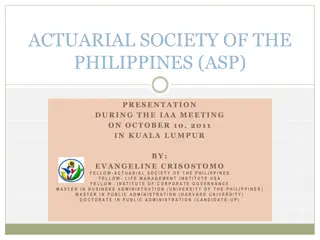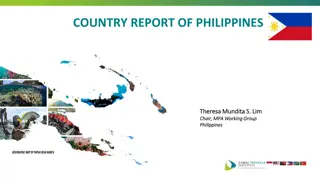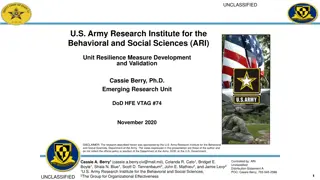Economic Resilience and Growth in the Philippines: A Success Story of Overcoming Financial Challenges
The Philippines faced economic turmoil with capital outflows, currency depreciation, and stock market crashes during crises, but rebounded with robust recovery and investment upgrades. Fiscal improvements, governance reforms, and investor confidence contributed to the country's emergence as a favored destination for foreign investments and credit upgrades, despite concerns of potential bubbles. The journey showcases the nation's resilience and potential amid global financial uncertainties.
Uploaded on Sep 30, 2024 | 6 Views
Download Presentation

Please find below an Image/Link to download the presentation.
The content on the website is provided AS IS for your information and personal use only. It may not be sold, licensed, or shared on other websites without obtaining consent from the author.If you encounter any issues during the download, it is possible that the publisher has removed the file from their server.
You are allowed to download the files provided on this website for personal or commercial use, subject to the condition that they are used lawfully. All files are the property of their respective owners.
The content on the website is provided AS IS for your information and personal use only. It may not be sold, licensed, or shared on other websites without obtaining consent from the author.
E N D
Presentation Transcript
Financial Situation in the Philippines Joseph Anthony Lim
The Philippines continued its capital account openness and free floating exchange rate despite the bad experiences in the Asian crisis and the global financial crash. Massive capital outflows and stock market crash cut the stock market index by half from late 2007 to mid 2009. The peso depreciated from P40 to a $1 to more than P48 to a $1. Specter of Asian crisis plus export collapse!
The real economy recovered strongly in 2010 (from 1% GDP growth in 2009 to around more than 7% growth in 2010). The Eurodebt crisis and an inability to pump prime the economy in 2011 brought the growth rate below 4%. Then in 2012, the Philippines got a series of investment upgrade (investments of course improved), the government pump primed the economy substantially and miraculously Phil exports increased. This brought Philippine growth to a surprising 6.6% growth rate, the 2ndlargest in Asia, just next to China.
The investment upgrade was due to the improvement of the fiscal position, especially with the imposition of taxes on cigarettes and alcohol ( sin taxes) and declining deficits The upgrade was also due to better governance with the current administration not experiencing exposures of corruption on big scandals on projects and election-rigging as the previous administration Business confidence on the new Administration is also high.
Since then till now, the Philippines is now the darling of the foreign investors and rating agencies. The Philippines got another credit upgrade bringing it to investment grade this year. From 2010 to present, the stock market index doubled. Capital inflows surged. Together with high overseas workers remittances, international reserves reached $84 billion in May 2013, equivalent to almost 1 year of imports
The high inflows of hot money is such that even the rating agencies and multilateral agencies have warned of a growing bubble and its possible bursting. But except for UN ESCAP, none are calling for capital controls. Just recently in early May (2013), the Central Bank Governor announced that the Philippines will not undertake capital controls. Apparently they do not want to risk the current star stature of the Philippines. The specter of Thailand attempting to do drastic capital controls on the equities market must also figure prominently in this decision.
Stock market is now overvalued and a bubble is growing. It is not clear if a property bubble is occurring but construction of condominiums is growing tremendously, its prices are soaring and loans to real estate is outpacing loans to manufacturing. Loans are also growing at a fast pace and a financial bubble may also be forming.
But what worries the Central Bank and mainstream academics more is the sharp appreciation of the peso. The CB has kept its overnight borrowing rate low at 3.5% and decreased the rate for the special deposit account (SDA) several times and is now at 2%. The low interest rates are to discourage investment on the peso, but the attraction of the foreign investors is really the stock market that just keeps zooming up. Paradoxically the very low interest rate and monetary easing in the Philippines encourage stock market investments from the locals. The resulting increase in the stock market index attracts foreign investors more.
The CB also put foreign exchange borrowing limits on financial institutions to limit foreign exchange entry into the country. The Department of Finance had been borrowing dollars from the CB to finance some of its debt payments DOF also announced that the Philippines will limit sovereign borrowing and use more domestic debt. Although stemming the peso appreciation may be the main objective, it has a beneficial result of reduce foreign exchange risk on the country s debt. All these partly to stem the peso s rise.
The attempt to stem foreign inflows is laudable but massive capital inflows is due to quantitative easing in the developed countries, especially the US, and the Philippines own low interest rates contributing to the stock market bubble and continuing appreciation of the peso. The attraction of portfolio investors is the stock market prices that just keeps on going up. Despite Philippines low interest rate, the interest rate due to QE of developed countries had led to much lower interest rates in developed countries than the Philippines The Philippine CB and national gov t cannot avoid the capital controls if they want to stem the massive hot money inflows contributing strongly to the appreciation of the peso.
Other matters In the banking sector, the attempt of the Central Bank to avoid bank failures had resulted in the CB being too strict on rural and thrift banks. These banks cater more to small borrowers and SMEs compared to the bigger commercial banks.
Sovereign Wealth Fund There are now much talk in the Philippines of creating a Sovereign Wealth Fund In its charter, the Philippine Central Bank can only invest the international reserves in safe and non-risky assets like the US Treasury bills. Because of the huge reserves lying dormant, the CB Governor recently suggested that the National Gov t purchase dollars from the Central Bank to create a Sovereign Wealth Fund that can invest offshore.
Some suggests that the dollar fund can be used to guarantee loans for vital infrastructure projects (e.g. telecommunications, toll roads) as Abu Dhabi Investment Co. had done. Some suggest using the money for local development projects and using the dollars for Philippine projects import needs. Some suggest that countries in the region can use the dollar reserves and in a new regional development bank that is more progressive (Ocampo and Griffith Jones (2006), Limmahhui (2010)).
Regional Cooperation Regional cooperation is needed to protect emerging markets from global contagion, and to facilitate economic development. Regional development funds for fiscal purposes can be accumulated from the high international reserves of the East Asian countries with conditionalities less stringent than the current ones of the multilateral agencies. Current regional arrangements such as the Chiang Mai Initiative Multilitaralisation (CMIM) and bilateral/ multilateral currency swaps deal only with liquidity currency problems and not fiscal needs, and 80% of the loans is tied to IMF conditionalities A regional stand on capital flow management and controls will also help in stemming the overflow of portfolio investments causing risks of asset bubbles, overvaluation of currencies, and harmful massive reverse flows due to negative shocks whether external or internal.























